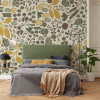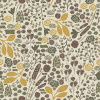1. Furniture with Purpose
Choose furniture made from FSC-certified wood, recycled materials, or second-hand pieces. Durability and repairability are key concepts. Every piece of furniture that doesn’t need to be newly manufactured saves valuable resources.
2. Textiles Made from Natural Materials
Opt for curtains, cushions, or rugs made of organic cotton, linen, or recycled PET. These fabrics are free from harmful chemicals and promote a healthy indoor environment.
3. Sustainable Wall Design
Wall design offers many opportunities to benefit both the environment and your well-being. Sustainable wallpapers made from recycled or FSC-certified materials, water-based paints, and solvent-free adhesives are eco-friendly alternatives to conventional products.
Non-woven wallpapers with eco-certifications are especially advantageous: they’re long-lasting, breathable, and free from PVC and harmful plasticizers.
A pleasant side effect: natural materials often improve indoor air quality by regulating humidity and creating a healthier living atmosphere. In this way, wall design becomes not just an aesthetic choice, but also a conscious and sustainable element of your living concept.
4. Smart Lighting Choices
LED lights with high energy efficiency and dimming capabilities save electricity and emit less heat. Smart home solutions help control lighting usage—only where and when it’s needed.
5. Less Is More: Embrace Minimalism
A sustainable lifestyle also means consuming less—bringing clarity to both your space and your mind. Sustainable living starts with mindful choices—from furniture to wall finishes.
Those who think ecologically don’t just create a beautiful home, but one that’s healthy and future-ready. Every small step counts—and with the right inspiration, the transition becomes effortless.
















